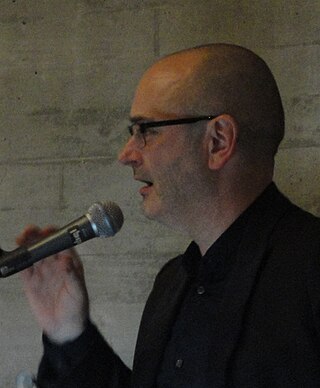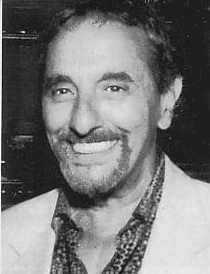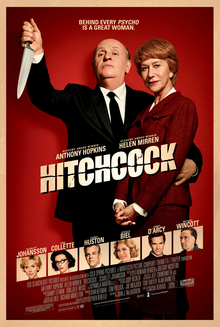
Sir Alfred Joseph Hitchcock was an English film director. He is widely regarded as one of the most influential figures in the history of cinema. In a career spanning six decades, he directed over 50 feature films, many of which are still widely watched and studied today. Known as the "Master of Suspense", Hitchcock became as well known as any of his actors thanks to his many interviews, his cameo appearances in most of his films, and his hosting and producing the television anthology Alfred Hitchcock Presents (1955–65). His films garnered 46 Academy Award nominations, including six wins, although he never won the award for Best Director, despite five nominations.

Psycho is a 1960 American horror film produced and directed by Alfred Hitchcock. The screenplay, written by Joseph Stefano, was based on the 1959 novel of the same name by Robert Bloch. The film stars Anthony Perkins, Janet Leigh, Vera Miles, John Gavin, and Martin Balsam. The plot centers on an encounter between on-the-run embezzler Marion Crane (Leigh) and shy motel proprietor Norman Bates (Perkins) and its aftermath, in which a private investigator (Balsam), Marion's lover Sam Loomis (Gavin), and her sister Lila (Miles) investigate her disappearance.

Bill Viola is an American contemporary video artist whose artistic expression depends upon electronic, sound, and image technology in new media. His works focus on the ideas behind fundamental human experiences such as birth, death and aspects of consciousness.

Douglas Gordon is a Scottish artist. He won the Turner Prize in 1996, the Premio 2000 at the 47th Venice Biennale in 1997 and the Hugo Boss Prize in 1998. He lives and works in Berlin, Germany.
Psychological horror is a subgenre of horror and psychological fiction with a particular focus on mental, emotional, and psychological states to frighten, disturb, or unsettle its audience. The subgenre frequently overlaps with the related subgenre of psychological thriller, and often uses mystery elements and characters with unstable, unreliable, or disturbed psychological states to enhance the suspense, horror, drama, tension, and paranoia of the setting and plot and to provide an overall creepy, unpleasant, unsettling, or distressing atmosphere.

Laura Mulvey is a British feminist film theorist and filmmaker. She was educated at St Hilda's College, Oxford. She is currently professor of film and media studies at Birkbeck, University of London. She previously taught at Bulmershe College, the London College of Printing, the University of East Anglia, and the British Film Institute.

Vera June Miles is an American retired actress, best known for roles in the John Ford directed, John Wayne starring Westerns The Searchers (1956) and The Man Who Shot Liberty Valance (1962) as well as for playing Lila Crane in the Alfred Hitchcock film Psycho, later reprising the role in its sequel, Psycho II.

Joseph William Stefano was an American screenwriter, known for adapting Robert Bloch's novel as the script for Alfred Hitchcock's film Psycho, and for being the producer and co-writer of the original The Outer Limits television series.

Empire is a 1965 American black-and-white silent art film by Andy Warhol. When projected according to Warhol's specifications, it consists of eight hours and five minutes of slow motion footage of an unchanging view of New York City's Empire State Building. The film does not have conventional narrative or characters, and largely reduces the experience of cinema to the passing of time. Warhol stated that the purpose of the film was "to see time go by."
Video installation is a contemporary art form that combines video technology with installation art, making use of all aspects of the surrounding environment to affect the audience. Tracing its origins to the birth of video art in the 1970s, it has increased in popularity as digital video production technology has become more readily accessible. Today, video installation is ubiquitous and visible in a range of environments—from galleries and museums to an expanded field that includes site-specific work in urban or industrial landscapes. Popular formats include monitor work, projection, and performance. The only requirements are electricity and darkness.
Identification refers to the automatic, subconscious psychological process in which an individual becomes like or closely associates themselves with another person by adopting one or more of the others' perceived personality traits, physical attributes, or some other aspect of their identity. The concept of identification was founded by psychoanalyst Sigmund Freud in the 1920’s, and has since been expanded on and applied in psychology, social studies, media studies, and literary and film criticism. In literature, identification most often refers to the audience identifying with a fictional character, however it can also be employed as a narrative device whereby one character identifies with another character within the text itself.

Stan Douglas is an artist based in Vancouver, British Columbia.

Doug Aitken is an American multidisciplinary artist. Aitken's body of work ranges from photography, print media, sculpture, and architectural interventions, to narrative films, sound, single and multi-channel video works, installations, and live performance. He currently lives in Venice, California, and New York City.

Psycho is an American horror franchise consisting of six films loosely based on the Psycho novels by Robert Bloch: Psycho, Psycho II, Psycho III, Bates Motel, Psycho IV: The Beginning, the 1998 remake of the original film, and additional merchandise spanning various media. The first film, Psycho, was directed by filmmaker Alfred Hitchcock. Subsequently, another film related to the series was made: an Alfred Hitchcock biopic, and two new novels, by Takekuni Kitayama and Chet Williamson, were released. Also, an independent documentary called The Psycho Legacy was released on October 19, 2010, mostly focusing on Psycho II, Psycho III and Psycho IV: The Beginning, while covering the impact and legacy of the original film.
Peter Campus, often styled as peter campus, is an American artist and a pioneer of new media and video art, known for his interactive video installations, single-channel video works, and photography. His work is held in the collections of numerous public institutions, including The Museum of Modern Art, Whitney Museum of American Art, Solomon R. Guggenheim Museum, Hamburger Bahnhof - Museum für Gegenwart, Tate Modern, Museo Reina Sofía, Albright-Knox Art Gallery, Walker Art Center, and the Centre Georges Pompidou. The artist works on the south shore of Long Island.
Ian Carr-Harris is a Canadian artist living in Toronto. In addition to exhibiting internationally, Carr-Harris is a professor at the Ontario College of Art and Design.
Peter Sarkisian is an American new media artist based in Santa Fe, New Mexico. He combines video projection and sculpture to create hybrid-format, multi-media installations.
Klaus Biesenbach is a German curator and museum director. He is the Director of the Neue Nationalgalerie, with Berggruen Museum and Scharf-Gerstenberg Collection, as well as the Berlin Museum of Modern Art under construction, Museum des 20. Jahrhunderts.

Hitchcock is a 2012 American biographical romantic drama film directed by Sacha Gervasi and based on Stephen Rebello's 1990 non-fiction book Alfred Hitchcock and the Making of Psycho. Hitchcock tells the story of the relationship between Alfred Hitchcock and his wife, Alma Reville, during the filming of Psycho in 1959. Hitchcock premiered at the AFI Fest on November 1, 2012 and was released in the United States on November 23 by Fox Searchlight Pictures. It grossed $27 million against a $15 million budget.

Johan Grimonprez is a Belgian multimedia artist, filmmaker, and curator. He is most known for his films Dial H-I-S-T-O-R-Y (1997) which the Guardian included in its article From Warhol to Steve McQueen: a history of video art in 30 works, Double Take (2009) and Shadow World: Inside the Global Arms Trade (2016), based on the book by Andrew Feinstein. Grimonprez wrote and directed the documentary Soundtrack to a Coup d'Etat about the promise of decolonisation, the hope of the non-aligned movement and the dream of self-determination.













